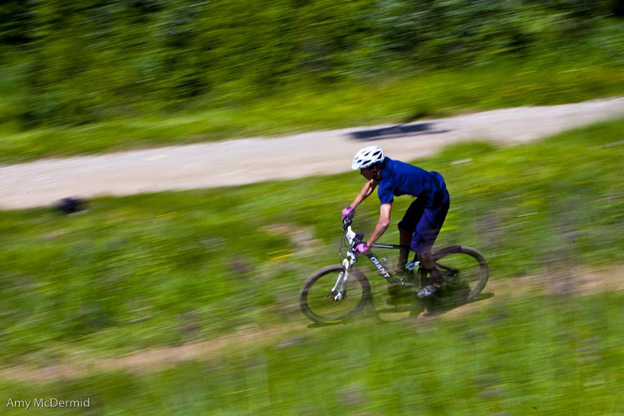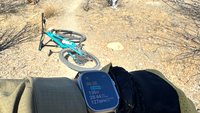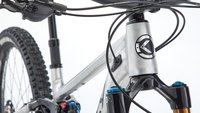
Interviews: Arthur Gaillot and Dylan Wolsky
For the week of January 24 to 27, NSMB will be bringing you exclusive content about Enduro racing. There are more of these races popping up each year fed by enthusiastic organizers and keen competitors who want value for their money – Enduros generally mean a lot more time on your bike than downhill or even cross-country races – and a bit of biking fun. So what next?
Arthur Gaillot and Dylan Wolsky are two BC racers who have their sights set on the international Enduro circuit for 2012. We caught up with Arthur and Dylan to find out what gets them stoked on Enduro, what makes it different from other disciplines, and how it affects the rest of mountain biking.
Arthur Gaillot
Arthur Gaillot is North Vancouver’s great white hope for Enduro racing. A highly skilled rider with some long levers makes him a threat for some serious Enduro races this year. He has been training and focusing on particular events this year after having a few years exploring what is out there and where his potential lies.
NSMB: What is Enduro racing?
AG: I’d say being timed to ride little bikes on rough terrain, mostly pointed down but also up and across.
Enduro seems like a broad term that is used to describe many forms of racing. Is this because it is getting to know itself or that variety is the spice of life?
I’m assuming you’re thinking Super D, Enduro DH, etc… I believe there are mostly two different takes on the concept: Super D originating in North America, Enduro with its roots in Europe. I would say that Super D has a focus towards fitness and smoother courses, where a shorter travel and light trail bike does best – think great climbing bike that can still descend. XC guys with good skill are head of the pack, with a few exceptions. I see Enduro as more focused on skill with rougher courses. Best bike? Think one that is excellent on the downs, while still being able to climb.
This sums it up for me: I ended up with Karim Amour (Euro Enduro top dog, ex four cross killer, and generally highly-titled mountain bike racer) on the lift up to Garbonzo last year at the Crankworx Enduro. In a chat about the race format, he mentioned early on how this was the first time he had ever ridden his (barely) six inch bike without a full-face helmet and full pad set! Goes to show what the Euro courses are like…
These days, it seems like Enduro in North America is associated with a type of race format. Basically, multiple timed stages over the course of maybe one or more days, with same equipment constraints (tires, wheels, suspension): Crankworx Enduro, Trestle Park Enduro, or even within an existing race, like the timed Enduro stages within BC Bike Race.
The UCI have clearly asserted that they plan to work with existing Enduro race organizers in the hope that a World Series of World Championship can arise. This question is two fold: What are the benefits to elite Enduro racers having a World Series? And what does this mean to the average rider who takes part in these races?
In my mind, legitimizing this type of racing will overall benefit all riders and the industry as a whole. A legitimate series with UCI points will bring more funds into the discipline, and enable racers in North America to justify focusing on Enduro type events. Currently in North America, sponsors require athletes to race their main discipline (XC or DH) first and foremost, with Enduro/Super D style events as secondary exposure only. Only a very select few are able to have Enduro racing as a career on this side of the ocean. A world points series will mean working up to a regular schedule of North American Enduro events benefiting all riders, paid or not: more selection, more course variety, hopefully varied formats as well. Any growth of this proportion will be further reflected in development and product offerings from components and frame manufacturers. We are seeing it already: light, mid travel bikes with aggressive geometries, double ring chainguides, adjustable height seatposts, light and stiff mid travel suspension forks with excellent damping characteristics, EXO casing on Maxxis tires, or more aggressive tread on XC tires, and the list goes on…
My one area of concern with Enduro becoming a UCI discipline is regarding equipment and format constraints. I like the idea of all-mountain racing as a whole, with different formats (stage race, staggered or mass start, single or multi-day, etc.) adding flavour and variety to a season of racing. Hopefully the classification of “Enduro” will be given some flexibility format-wise in the rules established by the UCI, or whoever the governing body may become. This applies to equipment as well. Show up to Ashland for the annual Mountain Challenge for example, and you’ll see everything from 6”+ bikes with coil suspension and meatier tread, to XC 29” wheeled-hardtails with belt drives. Riders on heavier bikes need to make up time on the downs and riders on lighter bikes will blow their heart out on the ups and flats. This gives everyone a different strategy and allows the race to appeal to riders of all backgrounds. If all of a sudden you start limiting weight, travel, wheel size, and so on, you’re greatly reducing the target market and general appeal of the format.
What does Enduro racing mean to the average rider? What relevance has Enduro racing got with everyday riding?
My top three reasons why Enduro racing has the broadest appeal of any mountain bike discipline today:
- Best-suited bike is probably the bike you’d want to own and ride most of the time. No more ‘race bike’, ‘training bike’, just one bike that’s fun to ride pretty much no matter what.
- Skill and fitness are both important. Most riders have a combination of each, in different proportions. Everyone will have his or her time to shine, and experience a gratifying race moment at some point.
- It’s the way most of us ride anyway for fun, so you might as well be racing!
Do you think Enduro racing has the potential to help push mountain biking to a more mainstream audience?
Hard to say. Mainstream likes spectacles. Downhill is more spectacular than Enduro and perhaps more media friendly as well. The bikes that Enduro racing is breeding will definitely appeal to more people, but most of which are already mountain bikers, or at least cyclists. Enduro athletes might be more approachable to the public, or at least easier to relate to, as they seem to strike a happy medium between your typical cross-country athlete and your typical downhiller. In the end however, I see Enduro more so as being a way to bring cyclists together, rather than a way of introducing new people to the sport.
What are the top Enduro events?
They all have their own flavour. I would have had to race them all to answer your question. Thinking of MegAvalanche definitely makes my heart race: Top of a glacier mass start, 500 plus riders, 1000 plus sets of elbows to take you out, and some very driven Euros that will do pretty much anything to get ahead (did I mention they have sharp teeth?).
Ashland Mountain Challenge is a whole different atmosphere. Staggered start, smooth course, yet challenging in its own way: hucking twenty foot water bars with your saddle at full extension while spinning out your big wheels and your big ring! Stand at the start line, amidst tanned Californian racers most right off the cover of Men’s Health magazine, calves the size of my quads, bikes as if put together for a Decline showcase, immaculate decal placement clearly mandatory!
To answer your question, I’ll let you know 2012 favourites after this season once Dylan Wolsky, Chris Johnston and I get more of these under our belts. Ashland, Downieville, Crankworx Enduro, Trestle Park, Mountain of Hell, and MegAvalanche are all on the program.
Can you envision a time when Enduro racing eclipses all other forms of racing?
I hope not. What’s most fun for me does not need to be fun for everyone. Some aspire to extremely high levels of fitness and find their voice in cross-country racing, road, 24 hour races, you name it. Others identify riding with all-out speed, short intense efforts, and a dominating need for skill and guts, and find their fix in downhilling. I could see one day Enduro becoming the most popular discipline in off-road cycling, as in having the highest number of participants, but hopefully never to the point of extinguishing other formats.
Arthur slays whatever surface you put him on. Photo ~ Sterling Lorence
Dylan Wolsky
Who on earth is Dylan Wolsky? Well, if you live in the Sea-to-Sky Corridor then you will likely know his name but for those further afield then he might be less well-known. So let me enlighten you. Dylan is Aussie, but don’t hold it against him. He is a nice chap, but don’t hold that against him. He is fast up and down hill, but don’t hold it against him. What you should hold against him is a nice warm jacket when you are out in the alpine as a storm is coming in. Dylan is that guy…
Dylan won the 4Queens in 2010 and since then has been training for when the time to defend comes around. He coaches kids mountain biking in the summer, shovels snow in the winter, and is going to be hitting up the international Enduro race scene this year.
NSMB: Enduro seems like a broad term that is used to describe many forms of racing. Is this because it is getting to know itself or that variety is the spice of life?
DW: I think Enduro has been used as a broad term to classify a collective style of racing and riding in the past. Now that these styles of racing are becoming more popular they have been categorised more specific and are now becoming more individualized in their format. I think Super D in the past has been over shadowed with the Enduro term which left people scratching their heads on what the differences were between the two.
The UCI have clearly asserted that they plan to work with existing Enduro race organizers in the hope that a World Series of World Championship can arise. This question is two fold: What are the benefits to elite Enduro racers having a World Series? And what does this mean to the average rider who takes part in these races?
The Benefits to elite Enduro racers having a world series would be exposure on a world stage, and the riders would be able to represent their respected countries. It would bring Enduro racing into the spotlight alongside World Cup DH and XC events. It means to the average rider that they can be racing right next to the world’s best riders and have the oppurtunity to race the same tracks or even rub shoulders with them in races like the mega. They can also compare their times over stages with elite riders which makes it exciting and gets everyone involved.
Photo ~ Amy McDermid
What does Enduro racing mean to the average rider? What relevance has Enduro racing got with everyday riding?
It means for the average rider they can get involved with their friends and enjoy the fun of racing throughout the stages and spinning stories about their crazy runs, crashes, and so on riding between transitions, and share the stoke! Enduro racing shows a lot of relevance to everyday riding, its just the same as going out with a group of friends on a trail ride. You ride to the top of the climb then you bomb down the descent then laugh and chat on the next climb about it. These same bikes people use for everyday riding are usually perfect for Enduro racing aswell making an easy transistion into competitive Enduro racing without the hassle of buying specific bikes.
Do you think Enduro racing has the potential to help push mountain biking to a more mainstream audience?
For sure. You have taken XC and DH, blended it together, and have made this exciting new format. I still think it will take time to make it mainstream, but I do believe you can captivate and involve the broader mountain bike community from weekend warriors to your average casual trail riders. The majority of people that ride casually own trail bikes and if they could see people pushing that same bike to its limits in enduro racing I think this will intrigue people to get involved to either race or get out and ride more. Enduro is bringing mountain biking back to its roots.
What are the top Enduro events?
- Downieville
- Crankworx
- Megavalanche
- Ashland
- Trans-Provence
- Enduro of Nations
Can you envision a time when Enduro racing eclipses all other forms of racing?
I believe so – it’s spreading like wildfire and it will be interesting to see where it heads in 2012. A good example of this was when I was back in Australia last November and I turned up to a Sydney MTB club’s first Super D race. That race attracted more riders than any of their past club DH or XC races to date, and I believe it will be the first of many after that race. It just appeals to more people and the DH & XC racers all want to be a part of it as the Enduro format dabbles in both disciplines. Many riders are making the cross over.
Photo ~ Amy McDermid
Arthur and Dylan have a very positive approach going in to the 2012 Enduro season. We plan to keep up with them over the course of the season and continue to discuss the finer points of Enduro racing. Have any words for Gaillot and Wolsky? Let it be known below…
To see all the Enduro Week articles, click HERE.











Comments
Please log in to leave a comment.